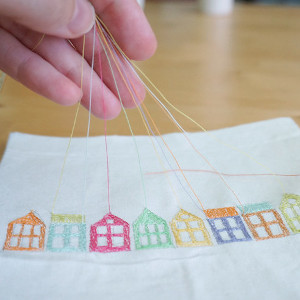 Free motion machine embroidery is a beautiful art that involves you, your sewing machine, and a whole lot of creative freedom. This is one of the most enjoyable ways to embroider. Free motion machine embroidery is extremely addictive, it allows you to bloom creatively, and it gives you maximum freedom to play with your own designs.
Free motion machine embroidery is a beautiful art that involves you, your sewing machine, and a whole lot of creative freedom. This is one of the most enjoyable ways to embroider. Free motion machine embroidery is extremely addictive, it allows you to bloom creatively, and it gives you maximum freedom to play with your own designs.
In essence, this is the art of sewing without restraints. You are basically drawing with thread. You don’t even need a special machine! With a few purpose-designed parts, you can be on the road to freestyle embroidering, which is exactly what we are talking about.
With free motion embroidery, you can create stunning visuals in a myriad of colors all with a keen eye, steady hands, and an artist’s love for the work. Let’s take an in-depth look at how to get started and what tools you are going to need.
How Do I Start Free Motion Machine Embroidery?
To start creating masterpieces with embroidery, you are going to need a bit of a setup. It is not much, just a sewing machine, a tweak to the dog teeth, and a specialized foot. It is really quite simple. Here are the main requirements to get you started free-motion machine embroidering today.
The Machine: Yes, there are specialized machines that will allow you to freestyle embroider with a spoiled person’s ease. But you do not need to spend a fortune on a professional embroidery machine. You can very easily use your standard sewing machine. Anything that sews with a straight stitch is going to work.
Don’t worry about decorative stitches, overloaded preset designs, or any of that fancy mumbo jumbo. All you need is a straight stitch machine and you can make whatever kind of free motion designs you want.
Dog Teeth: When you stitch normally, the dog teeth on your machine are up. They are what work to move the fabric front and back so that you can stitch in a straight line. If you don’t know what the dog teeth are, they are the gear-looking nubs beneath where your needle is that work like a conveyor belt.
Since we are doing free motion work, we do not want the dog teeth at all. We want a completely smooth surface so that we can manipulate the fabric in any way we choose. This means you need to disengage the dog teeth.
 You can either drop the teeth by using a switch found often near the back or underneath the bobbin case area. However, if your machine does not have this switch, it probably has a darning plate that will clip overtop the teeth to give you free motion. This basically raises the plate level high enough that the dog teeth won’t interfere with your free-motion work.
You can either drop the teeth by using a switch found often near the back or underneath the bobbin case area. However, if your machine does not have this switch, it probably has a darning plate that will clip overtop the teeth to give you free motion. This basically raises the plate level high enough that the dog teeth won’t interfere with your free-motion work.
Now you are able to shift in any direction you want while sewing, thereby giving you the ability to draw with the thread. It may seem a little silly at first, and even a little difficult, but once you start getting into the hang of things you will love it. I personally think it feels more like crafting art out of clay than traditional sewing.
Sewing Foot: Unfortunately, you need the proper foot to do machine embroidery. You must have a spring-loaded foot that can bounce. These specialized feet are often known as darning feet. You can use either a closed darning foot or an open toe darning foot.
The closed darning foot is better if you are stitching over a variety of thicknesses, different materials, or creating a complex patchwork. If you are embroidering on a single fabric and on a single layer, you are perfectly fine using and open toe darning foot.
I should note that professionals who have been free motion embroidering for many years often don’t even use a foot. But if this is your first time, I highly recommend using a foot!
An open toe darning foot will allow you to see exactly what you are stitching while using no foot is going to mean you need to stitch incredibly quickly so that the fabric does not hoop and bunch. This is not only going to be stressful, but it can lead to ruined projects for the inexperienced.
What Kind of Thread Should I Use for Free Motion Embroidery?
 Now that you have set your machine to do some free motion embroidery, you are going to need some quality thread.
Now that you have set your machine to do some free motion embroidery, you are going to need some quality thread.
For this type of action, you want strong thread. No cheap stuff when working freehand. Not because I want you to spend more money, but because it is going to be hard on your threads when you are sewing in all kinds of different directions. If your thread is not strong enough, it could snap easily and frequently.
You also don’t want thread that is too thick. My recommendation is a thread that is either 40 or 50 weight. This is the sweet spot for free motion embroidery. Cotton thread is ideal, but you may also enjoy using a special rayon thread.
As for color, obviously you can use any color you want. I’m sure your creative projects are going to be rich with vivid colors!
What Type of Needle Should I Use for Free Motion Embroidery?
I see absolutely no reason to go out and buy a fancy set of needles. A regular machine needle is going to work great with your 40 or 50 weight thread. If you want numbers, any needle that is size 70 to 80.
If you choose to use a heavier thread, obviously you will need to increase the size of your needle accordingly. Do keep in mind that there are no rules here. Free motion is all about freedom, which means you get to set your own parameters.
That said, I do have a few more recommendations. If you end up stitching a large quantity of paper, you may want to use a leather needle as it will last longer. If using a thicker thread, I suggest a topstitch needle. And finally, be sure to change your needle frequently because it is going to take a whole lot of punishment from this style of embroidering.
Last but not least, have fun!


